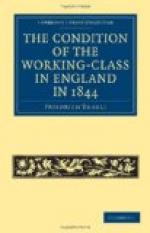the death-rate of several large towns is as follows:—In
Manchester, including Chorlton and Salford, one in
32.72; and excluding Chorlton and Salford, one in
30.75. In Liverpool, including West Derby (suburb),
31.90, and excluding West Derby, 29.90; while the
average of all the districts of Cheshire, Lancashire,
and Yorkshire cited, including a number of wholly
or partially rural districts and many small towns,
with a total population of 2,172,506 for the whole,
is one death in 39.80 persons. How unfavourably
the workers are placed in the great cities, the mortality
for Prescott in Lancashire shows: a district
inhabited by miners, and showing a lower sanitary
condition than that of the agricultural districts,
mining being by no means a healthful occupation.
But these miners live in the country, and the death-rate
among them is but one in 47.54, or nearly two-and-a-half
per cent. better than that for all England. All
these statements are based upon the mortality tables
for 1843. Still higher is the death-rate in
the Scotch cities; in Edinburgh, in 1838-39, one in
29; in 1831, in the Old Town alone, one in 22.
In Glasgow, according to Dr. Cowen, {106} the average
has been, since 1830, one in 30; and in single years,
one in 22 to 24. That this enormous shortening
of life falls chiefly upon the working-class, that
the general average is improved by the smaller mortality
of the upper and middle-classes, is attested upon all
sides. One of the most recent depositions is
that of a physician, Dr. P. H. Holland, in Manchester,
who investigated Chorlton-on-Medlock, a suburb of
Manchester, under official commission. He divided
the houses and streets into three classes each, and
ascertained the following variations in the death-rate:
First class of Streets. Houses I. class. Mortality one in 51 ,, ,, ,, II. ,, ,, ,, 45 ,, ,, ,, III. ,, ,, ,, 36 Second ,, ,, I. ,, ,, ,, 55 ,, ,, ,, II. ,, ,, ,, 38 ,, ,, ,, III. ,, ,, ,, 35 Third ,, ,, I. ,, Wanting —– —— ,, ,, ,, II. ,, Mortality ,, 35 ,, ,, ,, III. ,, ,, ,, 25
It is clear from other tables given by Holland that the mortality in the streets of the second class is 18 per cent. greater, and in the streets of the third class 68 per cent. greater than in those of the first class; that the mortality in the houses of the second class is 31 per cent greater, and in the third class 78 per cent. greater than in those of the first class; that the mortality is those bad streets which were improved, decreased 25 per cent. He closes with the remark, very frank for an English bourgeois: {107}




